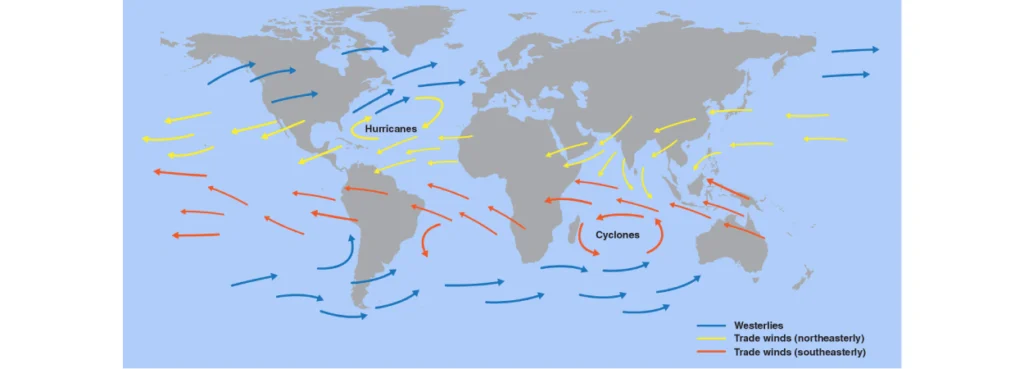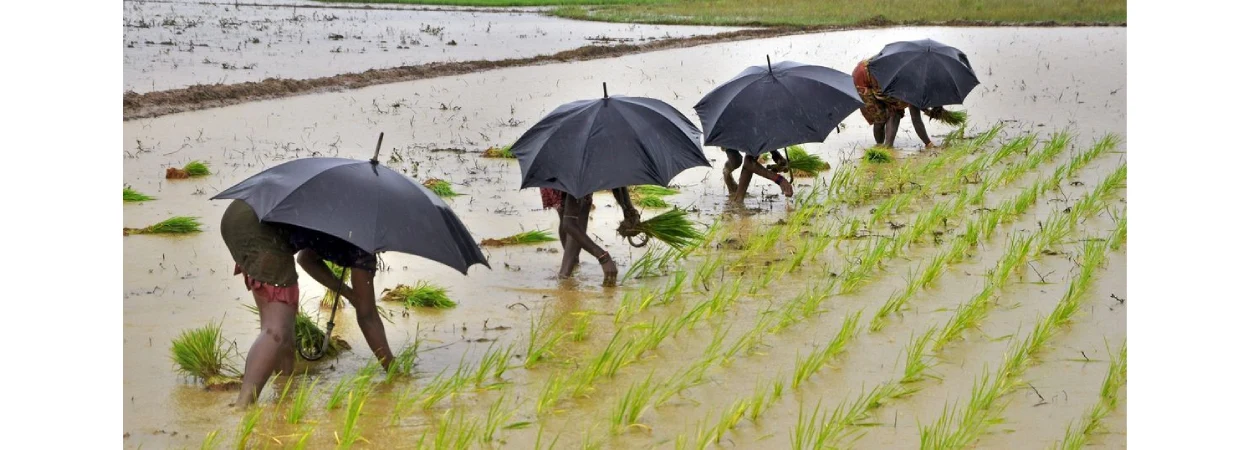Table of Contents
What is a monsoon?
A monsoon is a shift in winds that often causes a very rainy or dry season. It can occur in many tropical and subtropical regions, including several areas in the United States, although they are typically associated with parts of Asia. The most notable monsoon system in the world, the Indian monsoon, predominantly impacts India and the nearby water bodies. During the colder months, it blows from the northeast; during the hottest months of the year, it switches directions to blow from the southwest. Due to this process, much rainfall occurs in June and July.

Factors Shaping Indian Monsoon Formation
Differential heating of land and sea: The ground warms up faster than the ocean at the start of summer, thus creating low-pressure areas over land.
The Intertropical Convergence Zone (ITCZ): The Intertropical Convergence Zone, or ITCZ, is the region that circles the Earth near the equator, where the trade winds of the Northern and Southern Hemispheres come together. The intense sun and warm water of the equator heat the air in the ITCZ, raising its humidity and making it buoyant. Aided by the convergence of the trade winds, the buoyant air rises. As the air rises, it expands and cools, releasing the accumulated moisture in an almost endless series of thunderstorms.
"Winds that consistently blow from east to west just north and south of the equator are known as the trade winds. These winds assist ships in moving westward and can also direct storms like hurricanes."

The Himalayas: As the Sun (the Northern Hemisphere summer) moves northward during April, India becomes particularly prone to rapid heating because the Himalayas to the north protect it from any incursions of cold continental air.
The Tibetan Plateau: The average height of the plateau is 4000m and 2000km wide. Due to its elevation, it receives 2oC to 3oC more insolation than the neighbouring areas. It also acts as a physical barrier to cold continental winds from the north.

Jet Streams: Jet streams are bands of strong wind that generally blow from west to east all across the globe. They impact weather, air travel and many other things that take place in our atmosphere.
"The sub-tropical westerly Jet Stream is a chilly breeze that drives air to the surface and builds high pressure."
Tropical Easterly Jet Stream is a low-level jet stream near the tropopause over Southeast Asia, India, and Africa that occurs during summer. Its intensity is well correlated with the Indian summer monsoon rainfall.
Mechanism of The Indian Monsoon
The Onset of The South-West Monsoon:
- The ITCZ moves northward in June when the sun shines vertically over the Tropic of Cancer.
- The high-pressure area, east of Madagascar, is approximately 20°S over the Indian Ocean. The intensity and position of this high-pressure area affect the Indian Monsoon.
- Under the influence of the Coriolis force, the southeast trade winds of the southern hemisphere cross the equator and begin to blow in a southwest-to-northeast direction. These winds collect moisture as they travel over the warm Indian Ocean.
- The sub-tropical westerly Jet Stream builds high pressure over northern plains, thus blocking the favourable condition for the onset of monsoon.
- The ITCZ moves to 20°-25° N latitude towards the Indo-Gangetic Plain in July as the sub-tropical westerly jet stream departs from its location over the northern Indian plain, south of the Himalayas. In this position, the ITCZ is often called the Monsoon Trough.
- Only when the western jet stream has left the area does the easterly Jet Stream (Somali Jet) begin to develop approximately 15°N latitude. The burst of the Indian monsoon is attributed to this easterly jet stream.
- The relief and thermal low pressure over northwest India change the winds’ southwesterly direction as they near the land. The monsoon approaches the Indian landmass in two branches:
- The Arabian Sea branch – The Arabian Sea Branch of the south-west monsoon first hits the Western Ghats of the coastal state of Kerala, thus making this area the first to receive rain from the south-west monsoon. This branch of the monsoon moves northwards towards the western side.
- The Bay of Bengal branch –The Arakan Hills on the coast of Myanmar divert a significant section of the Bay of Bengal branch towards the Indian subcontinent. As a result, rather than coming from the southwest, the monsoon enters West Bengal and Bangladesh from the south and southeast.
- The monsoon is known for its tendency to produce ‘breaks’ in the rain.
As the monsoon trough runs close to the foothills of the Himalayas, monsoon winds ascend the slopes of the Himalayas resulting in orthographic rainfall. Low pressure is created due to no rain and excessive heating in the northern plains south of the ITCZ, which causes high pressure in the Bay of Bengal, thus blocking the way of moisture-laden winds towards the northern plain.
The Retreat of The South-West Monsoon:
- Clear skies and a temperature rise mark the retreating southwest monsoon season. The weather becomes somewhat unpleasant due to the high temperature and humidity. This is commonly known as the ‘October heat’.
- While the eastern section of the Peninsula experiences rain, north India experiences dry weather as the monsoon retreats. The wettest months of the year in this area are October and November.
- These depressions and cyclones that develop over the Andaman Sea are responsible for most of the rainfall along the Coromandel Coast.
The Effects of The Monsoon on Indian Life
- In India, 64% of the population relies on agriculture for a living, and agriculture depends on the monsoon. India’s agricultural development is largely dependent on timely and sufficient rainfall distribution. If it fails, agriculture suffers, especially in areas where irrigation systems are underdeveloped.
- Rainfall during the monsoon season replenishes dams and reservoirs, which are then utilised to produce hydroelectric power.
- Variability of rainfall brings droughts, floods and landslides in hilly regions.
Monsoon Prediction In India
- Although the IMD’s numerical models are state-of-the-art and were created by the US National Centres for Environmental Prediction, their forecasting ability is still limited due to the increased uncertainty that comes with longer forecast periods.
- The IMD uses 679 automated weather stations, 550 surface observatories, 43 radiosonde or weather balloons, 24 radars, and three satellites to gather meteorological data like temperature, humidity, wind, and precipitation.
Way Forward
- India’s population is growing, and to ensure that everyone has access to enough food, a significant portion of the monsoon water that is now wasted needs to be stored in appropriate sites for agriculture and power generation.
- India must devote more funds to improving monsoon forecasting and the severity of El Nino for sustainability and dependability.
- Climate change will cause the atmosphere to retain more moisture, resulting in higher rainfall and increased monsoon’s inter-annual variability. The nation must get ready for this transition.




